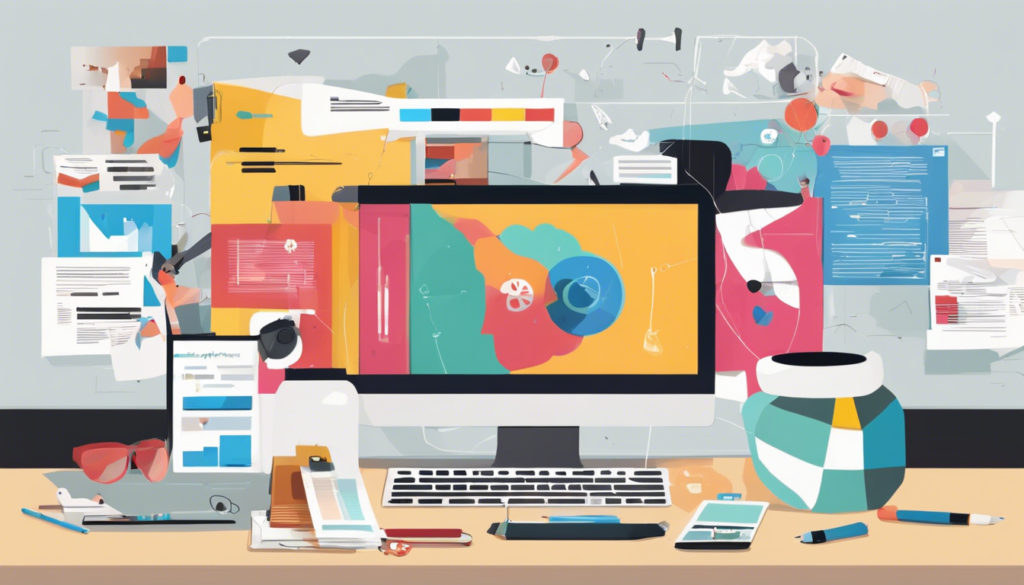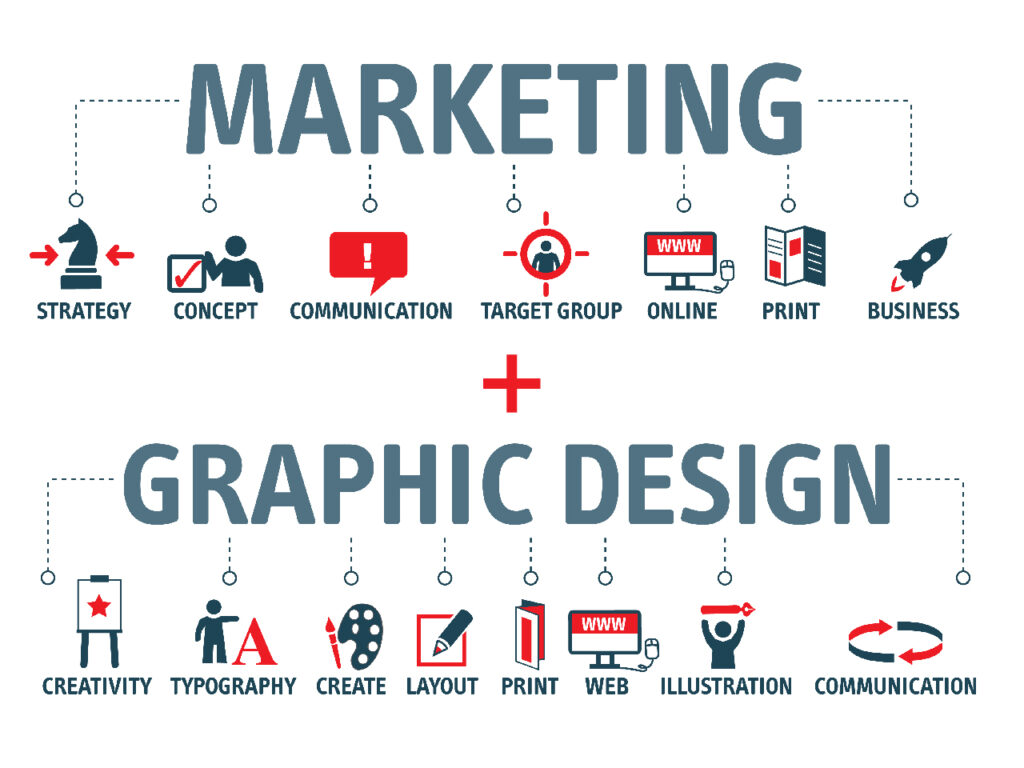Graphic Design and Marketing: A Powerful Duo for Digital Branding

In today’s visually driven digital landscape, the fusion of graphic design and marketing has become an indispensable powerhouse for crafting compelling digital branding and advertising narratives. This symbiotic relationship not only enhances the esthetic appeal of marketing materials. But also significantly boosts their effectiveness in engaging the target audience.
As businesses vie for attention in a crowded digital marketplace, incorporating graphic design into their digital marketing strategy. And it has emerged as a crucial component of success. By doing so, companies can communicate their message more clearly and create a lasting impression on their consumers. And thereby amplifying their digital advertising efforts.
This article delves into the pivotal role of graphic design in digital marketing, illustrating how it creates cohesive branding. And it enhances the overall digital marketing strategy.
The Importance of Graphic Design in Digital Marketing

Why Visual Appeal Matters
Visual appeal is a crucial aspect of digital marketing because it plays a significant role in attracting and retaining the attention of users. And it consequently influencing their engagement, perception, and decision-making process. In an era where consumers are inundated with information, a visually appealing presentation. And it can help a brand to stand out from the competition and establish a strong first impression.
The strategic use of colors, typography, layout, and imagery not only enhances the overall esthetics of marketing content. But also it helps to convey specific messages and emotions, thereby appealing to the target audience’s preferences and expectations. Furthermore, effective visual appeal contributes to seamless user experience, improved brand recall, and increased credibility. And ultimately leading to better conversion rates and customer loyalty.
Influence of Graphic Design on Consumer Psychology
Graphic design influences buying decisions in a variety of ways, from playing a major role in building the reputation and personality of a brand. Through to the way users navigate a website. A visually appealing design can capture the attention of potential customers. And make them more likely to explore further, creating a positive first impression.
A consistent and well-designed graphic identity helps build brand recognition. And when buyers can easily identify a brand through its logo, colors, and other design elements. They all are more likely to trust and choose that brand. And graphic design can evoke emotions and feelings, with certain colors and images making a product. And it seem more exciting, luxurious, or trustworthy, thereby driving buying behavior.
Effective graphic design communicates information clearly and concisely, helping to organize and present information in an easy-to-understand manner. So, it can be especially important for complex products or services.
Graphic design is a key component of advertising and promotions, with eye-catching designs making ads or promotions stand out and encouraging buyers to take action. Such as making a purchase or signing up for a service. In the case of digital products and services, graphic design is essential for creating a positive user experience. And with well-designed interfaces and navigation making it easier for customers to find what they need and complete a purchase.
Creating Cohesive Branding with Graphic Design

Creating a cohesive brand identity through graphic design elements is crucial for establishing a strong and recognizable presence in the digital marketplace. This involves carefully crafting various visual components that work harmoniously to convey the brand’s personality, values, and messaging consistently across all platforms.
Role of Colors, Fonts, and Images
Colors, fonts, and images play a pivotal role in shaping a brand’s visual identity and fostering cohesive branding. The strategic selection and consistent application of these elements can evoke specific emotions. So, they convey underlying meanings, and create a lasting impression on the target audience.
Colors:
The choice of colors is a powerful tool in branding. Different hues are associated with distinct emotions and perceptions. And making it essential to select a core brand color and complementary color palette that aligns with the desired brand personality and messaging. But the core color should be prominently featured in the logo, visuals, and marketing materials. While the supporting colors can add depth and variety to the overall esthetic.
Fonts:
Typography plays a significant role in shaping the brand’s voice and tone. Carefully selecting and consistently using a limited set of fonts (typically three: one for headings, one for subheadings, and one for body copy). It can enhance brand recognition and reinforce the brand’s personality. For example, a classic, calligraphic font can convey a sense of sophistication and elegance. While a bold, sans-serif font may communicate modernity and simplicity.
Logo, Imagery, and Icons:
The brand’s logo, imagery, and icons are visual representations that should be designed to align with the overall brand identity. These elements can range from simple, flat designs to more detailed and intricate styles. And depending on the desired brand personality and messaging. Consistent use of these visual assets across all marketing materials and platforms. And it is crucial for building brand recognition and reinforcing the brand’s cohesive identity.
Developing a Unique Brand Voice

In addition to visual elements, developing a unique and consistent brand voice is essential for cohesive branding. The brand voice encompasses the tone, style, and personality conveyed through written and verbal communication. Then reflecting the brand’s values and resonating with the target audience.
Defining the Brand Voice:
To establish a cohesive brand voice, it is crucial to define its key characteristics based on the brand’s mission, values, and target audience. This may involve determining the voice should be formal or casual, humorous or serious, authoritative or approachable, among other considerations.
Consistency Across Platforms:
Once the brand voice is defined, it should be consistently applied across all communication channels, including social media, email communications, website content, and marketing materials. This consistency helps to build trust and reinforces the brand’s identity. And ensuring that customers receive a uniform experience regardless of the platform they engage with.
Training and Guidelines:
To maintain consistency in the brand voice, it is essential to provide training and guidelines to all content creators, whether internal or external contributors. This can include creating a brand voice guide that outlines the core characteristics. And it provides examples, and offers tactical advice for capturing the desired tone and style in written content.
Leveraging Graphic Design in Various Digital Marketing Platforms

Graphic Design for Social Media
In the realm of digital marketing, social media design is a game-changer. Visual content, including social media graphics, has a significant impact on audience engagement. It’s more likely to be shared and liked on social media, enhancing the reach and visibility of your posts. Social media graphics play a crucial role in brand recognition. Consistent use of brand colors and design elements in your graphics can significantly enhance brand visibility and recognition.
High-resolution images with good composition are essential for creating engaging social media graphics. The rule of thirds can be used to enhance the visual appeal of your images. Branding and font choice are key elements in social media graphic design. Your brand’s colors should be subtly implemented in your graphics, and the fonts you choose should match your message and brand. So, balancing text and background is crucial in social media graphic design. And the color of the text should contrast with the background for readability, and important points should not be covered by text.
Using Graphic Design for Website Optimization
Web graphics are a double-edged sword; while they grab users’ attention and make websites more attractive, they can also slow down the website. Google ranks websites lower when they see huge image sizes because large images may not be liked by users. Therefore, a fine balance must be struck between the website’s speed and the use of web graphics to make it attractive.
All visual elements present as part of the design in websites or web applications are considered web graphics. When it comes to web graphics, a smaller image size is better. Because people don’t like waiting for an image to load for seconds when they come to your website.
Research shows that slower-loading websites lose sales and have a poor rank in Google’s search engine. If your website has larger-size images, Google will rank your website lower. Because your images are too big, and Google can predict people may not like this.
Tips for Effective Graphic Design in Marketing

Best Practices for Graphic Designers
A high-quality visual strategy and good use of graphic design can help businesses reach more customers, impress target audiences, and sell products or services better . Here are some best practices to turn design work into an effective asset in marketing efforts:
1) Develop Brand Guidelines: A brand guideline is a document that outlines a company’s visual identity, including brand colors, fonts, logos, imagery, and other design elements. But Designers should create comprehensive brand guidelines to ensure consistent branding across all marketing materials and platforms .
2) Create Unique Graphics for Blog Posts: Instead of using stock images, design unique graphics that help describe the subject matter or visualize complex concepts clearly. And this creates an impression that the blog is regularly updated and treated professionally. Additionally, adding alt text to images can help them rank in search engines, driving more traffic to the blog.
3) Leverage Graphic Design for Social Media: Develop a strong art direction and strategy to produce unique, bold, and catchy graphic designs for social media . Consistent visuals across marketing campaigns can help brands stand out and be remembered by their target audience .
4) Optimize Graphics for Websites: Ensure website graphics are optimized for faster loading times and better user experience. Use appropriate file formats (JPEG, PNG, SVG, WebP) based on the image type and desired quality. Compress images without compromising quality, and provide different sizes for desktop and mobile devices.
5) Incorporate Design Principles: Effective graphic design incorporates principles like color theory, shape, typography, contrast, hierarchy, repetition, and negative space. These elements can convey specific messages, evoke emotions, and enhance the overall visual appeal and brand identity.
6) Maintain Consistency: Ensure consistency in visual elements across all marketing channels, including websites, social media, email campaigns, and print materials. And Consistent branding reinforces the brand’s identity and builds trust and recognition among the target audience.
Conclusion
Through the exploration of the dynamic relationship between graphic design and marketing, this article has laid bare the crucial role that design plays in creating compelling digital branding and narrative. The intertwining of graphic elements with marketing strategies not only enhances the esthetic appeal but significantly elevates the effectiveness of engaging targeted audiences.
By meticulously selecting colors, fonts, images, and other design elements, companies can forge a unique identity, making their message clear and memorable. As we move forward, the importance of embracing graphic design in digital marketing endeavors is underscored by the ever-evolving digital landscape.
Leveraging design across various platforms, ensuring cohesive branding, and optimizing for user experience are fundamental in distinguishing a brand in the crowded marketplace. And the implications of adopting a strategic approach to graphic design are vast, potentially revolutionizing how brands engage with their audiences and drive conversions.
Frequently Asked Questions (FAQ's)
Q.1 Can graphic design and digital marketing be integrated?
Yes, graphic design is crucial for the effectiveness of digital marketing campaigns. It enhances customer engagement, increases traffic to websites, and promotes higher online sales.
Q.2 Are marketing and graphic design effective when combined?
Indeed, neither marketing nor graphic design can be fully effective without the other. When these two professions collaborate, they can craft campaigns that leave a lasting and positive impact, generating leads and driving results.
Q.3 What role does graphic design play in digital marketing?
Graphic design is vital for creating digital advertisements across various online platforms, such as display ads, PPC (pay-per-click) ads, and social media ads. Attractive visuals paired with effective copywriting can greatly improve ad performance and ROI by drawing in clicks and conversions.
Q.4 How does graphic design relate to branding?
Graphic design is utilized to communicate specific messages to targeted audiences, whereas branding focuses on building brand recognition and loyalty over time.



